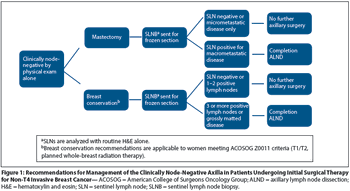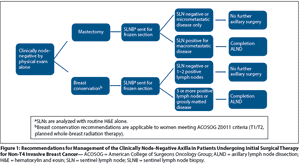
Here we review the evolution of sentinel lymph node biopsy for the management of clinically node-negative breast cancer, and we address the current controversies and management issues.

Your AI-Trained Oncology Knowledge Connection!


Here we review the evolution of sentinel lymph node biopsy for the management of clinically node-negative breast cancer, and we address the current controversies and management issues.

Increasing experience with magnetic resonance imaging (MRI) has raised important questions about how it should be used in breast cancer screening, and for presurgical evaluation and posttherapy follow-up of women with this disease. Overall, the availability of MRI as an adjunct to mammography and ultrasound offers clear clinical benefit to women at increased risk of breast cancer development due to BRCA1 and BRCA2 mutations, and to women presenting with axillary adenopathy and an occult primary breast tumor. In contrast, its benefit for routine selection of breast conservation or further assessment of lobular carcinoma in women of average risk has not been demonstrated.This article reviews the use of MRI in these settings, with an emphasis on the clinical outcomes that have been observed to date.

Inflammatory breast cancer (IBC) is a rare and aggressive form of the disease. It is diagnosed based on clinical signs of a rapidly enlarging, tender, erythematous, edematous breast that often presents without an underlying breast mass. IBC historically was considered a uniformly fatal disease. With the advent of multimodality treatments including primary systemic chemotherapy, surgery, and radiation therapy, approximately one-third of women diagnosed with IBC will become long-term survivors. This review examines the limitations of the current definition of IBC, explores our current understanding of the biology of IBC, and reviews the many exciting advances in locoregional and systemic treatment of IBC.

In 1992, the FDA decided that silicone gel-filled breast implants would be available only through controlled clinical studies, despite the fact that they had been used for mammoplasty in millions of women around the world

The Society of Surgical Oncology surgical practice guidelines focus on the signs and symptoms of primary cancer, timely evaluation of the symptomatic patient, appropriate preoperative evaluation for extent of disease, and role of the surgeon in

Published: October 1st 1998 | Updated:

Published: June 1st 1997 | Updated:

Published: May 1st 2007 | Updated:

Published: November 1st 2007 | Updated:

Published: May 15th 2014 | Updated: